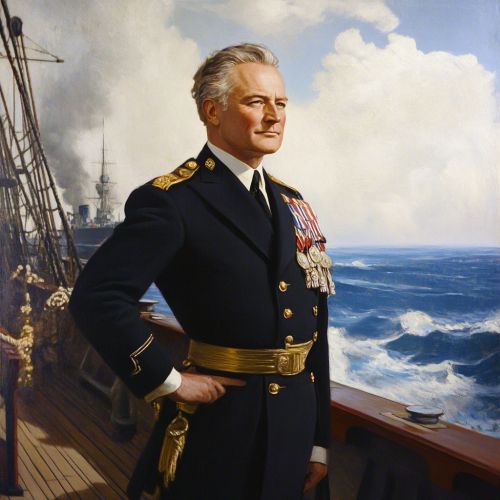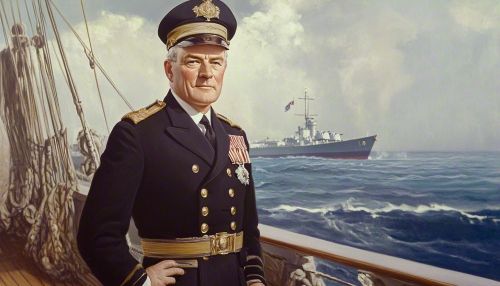Admiral Sir John Jellicoe: Difference between revisions
(Created page with "== Early Life and Naval Career == Admiral Sir John Jellicoe was born on December 5, 1859, in Southampton, England. He was the son of John Henry Jellicoe, a captain in the merchant service, and Lucy Henrietta Keele. Jellicoe's early education took place at a local school in Southampton before he joined the Royal Navy as a cadet in 1872. His naval career began at the age of 13 when he entered the Royal Naval College at Dartmouth, whe...") |
No edit summary |
||
| Line 23: | Line 23: | ||
Jellicoe's decisions during the Battle of Jutland have been the subject of extensive analysis and debate. While some criticized his cautious approach, others argued that his primary objective was to preserve the fleet and maintain naval supremacy. His strategic acumen and understanding of the broader implications of naval warfare were evident in his handling of the fleet. | Jellicoe's decisions during the Battle of Jutland have been the subject of extensive analysis and debate. While some criticized his cautious approach, others argued that his primary objective was to preserve the fleet and maintain naval supremacy. His strategic acumen and understanding of the broader implications of naval warfare were evident in his handling of the fleet. | ||
[[Image:Detail-98587.jpg|thumb|center|A portrait of Admiral Sir John Jellicoe in full naval uniform, standing on the deck of a battleship with the sea in the background.|class=only_on_mobile]] | |||
[[Image:Detail-98588.jpg|thumb|center|A portrait of Admiral Sir John Jellicoe in full naval uniform, standing on the deck of a battleship with the sea in the background.|class=only_on_desktop]] | |||
== Post-War Career and Legacy == | == Post-War Career and Legacy == | ||
Latest revision as of 09:06, 19 October 2024
Admiral Sir John Jellicoe was born on December 5, 1859, in Southampton, England. He was the son of John Henry Jellicoe, a captain in the merchant service, and Lucy Henrietta Keele. Jellicoe's early education took place at a local school in Southampton before he joined the Royal Navy as a cadet in 1872. His naval career began at the age of 13 when he entered the Royal Naval College at Dartmouth, where he excelled academically and demonstrated a keen aptitude for seamanship.
Jellicoe's early service included postings on various ships, where he gained experience in different naval operations. He was promoted to sub-lieutenant in 1878 and lieutenant in 1880, serving on the HMS Agincourt and later on the HMS Monarch. His technical skills and leadership qualities were evident early on, and he quickly rose through the ranks.
Rise to Prominence
Jellicoe's career trajectory took a significant turn when he was appointed as a gunnery officer on the HMS Colossus in 1886. His expertise in naval gunnery and tactics was recognized, and he played a pivotal role in advancing the Royal Navy's gunnery practices. In 1891, he was promoted to commander and took part in the Benin Expedition, where he demonstrated exceptional leadership and strategic acumen.
In 1897, Jellicoe was promoted to captain and given command of the HMS Centurion, serving in the China Station. During the Boxer Rebellion, Jellicoe was wounded but continued to lead his men with distinction, earning the respect of his peers and superiors. His actions during this period solidified his reputation as a capable and courageous officer.
The Dreadnought Era
The early 20th century saw significant advancements in naval technology, particularly with the introduction of the Dreadnought-class battleships. Jellicoe was a key figure in the development and implementation of these new warships, which revolutionized naval warfare. His technical knowledge and strategic foresight were instrumental in shaping the Royal Navy's approach to modern naval combat.
In 1907, Jellicoe was appointed Director of Naval Ordnance, where he oversaw the development and procurement of naval armaments. His contributions during this period were critical in ensuring that the Royal Navy maintained its technological edge over potential adversaries. In 1910, he was promoted to rear-admiral and subsequently served as the Second Sea Lord, where he continued to influence naval policy and strategy.
World War I and the Battle of Jutland
With the outbreak of World War I, Jellicoe was appointed Commander-in-Chief of the Grand Fleet, the main battle fleet of the Royal Navy. His leadership was put to the test during the Battle of Jutland in 1916, the largest naval battle of the war. The battle was a strategic stalemate, but Jellicoe's cautious tactics ensured that the Grand Fleet remained a formidable force, capable of maintaining the blockade of Germany.
Jellicoe's decisions during the Battle of Jutland have been the subject of extensive analysis and debate. While some criticized his cautious approach, others argued that his primary objective was to preserve the fleet and maintain naval supremacy. His strategic acumen and understanding of the broader implications of naval warfare were evident in his handling of the fleet.


Post-War Career and Legacy
After the war, Jellicoe was appointed First Sea Lord, the professional head of the Royal Navy. In this role, he focused on post-war naval policy and the reorganization of the fleet. His tenure as First Sea Lord was marked by efforts to modernize the navy and address the challenges of a rapidly changing geopolitical landscape.
In 1920, Jellicoe was elevated to the peerage as Viscount Jellicoe of Scapa, in recognition of his service to the nation. He continued to be involved in naval affairs and served as Governor-General of New Zealand from 1920 to 1924. His contributions to naval strategy and leadership left a lasting impact on the Royal Navy and the broader field of naval warfare.
Jellicoe passed away on November 20, 1935, leaving behind a legacy of dedication and service. His life and career continue to be studied by historians and military strategists, offering valuable insights into the complexities of naval command and the evolution of maritime strategy.
